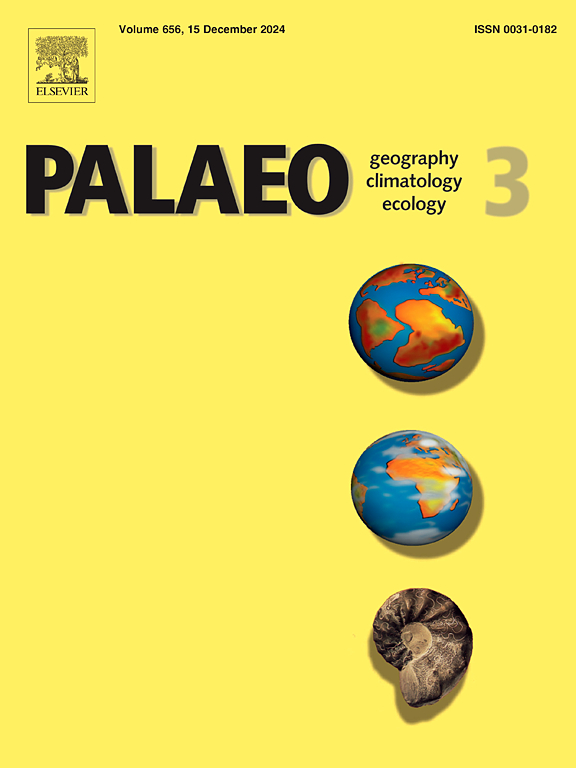First report of the hurdiid radiodont Ursulinacaris from the Cambrian Kaili Biota, South China
IF 2.7
2区 地球科学
Q2 GEOGRAPHY, PHYSICAL
Palaeogeography, Palaeoclimatology, Palaeoecology
Pub Date : 2025-05-17
DOI:10.1016/j.palaeo.2025.113036
引用次数: 0
Abstract
Radiodonts are globally distributed from the Cambrian Series 2 to Miaolingian. However, their occurrences in South China during the Miaolingian Epoch remains limited, particularly for hurdiids, which are highly abundant in other palaeocontinents. Here, we present the first discovery of hurdiid frontal appendages from the Cambrian Kaili Biota (Miaolingian) in South China. These appendages display distinctive morphological features, including five paired spiniform endites in the intermediate region, which facilitate their assignment to Ursulinacaris cf. U. grallae. This finding expands the palaeogeographic distributions of Ursulinacaris, which was previously thought to be confined to Laurentia in Miaolingian, and reinforces the biogeographic connection between Laurentia and South China during this time interval. An analysis of radiodont biodiversity patterns in Laurentian and South China suggests a shift in their evolutionary radiation center from shallow-water environments during the Cambrian Epoch 2 to deeper-water habitats of the Miaolingian. Furthermore, the alteration of radiodont biodiversity from the Cambrian Series 2 to Miaolingian may correlate with the Redlichiid-Olenellid Extinction Carbon Isotope Excursion (ROECE).

华南寒武纪凯里生物群hurdiid radiodoursulinacaris首次报道
从寒武纪二系到妙岭期,放射性物质在全球范围内分布。然而,它们在华南苗岭期的出现仍然有限,特别是在其他古大陆非常丰富的hurdiids。本文报道了在华南寒武纪妙岭期凯里生物群中首次发现的hurdiid额附。这些附属物表现出独特的形态特征,在中间区域包括五个成对的刺状端,这有助于它们被归类为Ursulinacaris cf. U. grallae。这一发现扩大了Ursulinacaris的古地理分布范围,强化了Laurentia与华南在这一时期的生物地理联系。对Laurentian和华南地区放射性生物多样性格局的分析表明,它们的进化辐射中心从寒武纪第2期的浅水环境向苗岭期的深水环境转移。此外,寒武系2 -苗岭期放射性生物多样性的变化可能与Redlichiid-Olenellid灭绝碳同位素偏移(ROECE)有关。
本文章由计算机程序翻译,如有差异,请以英文原文为准。
求助全文
约1分钟内获得全文
求助全文
来源期刊
CiteScore
5.90
自引率
10.00%
发文量
398
审稿时长
3.8 months
期刊介绍:
Palaeogeography, Palaeoclimatology, Palaeoecology is an international medium for the publication of high quality and multidisciplinary, original studies and comprehensive reviews in the field of palaeo-environmental geology. The journal aims at bringing together data with global implications from research in the many different disciplines involved in palaeo-environmental investigations.
By cutting across the boundaries of established sciences, it provides an interdisciplinary forum where issues of general interest can be discussed.

 求助内容:
求助内容: 应助结果提醒方式:
应助结果提醒方式:


